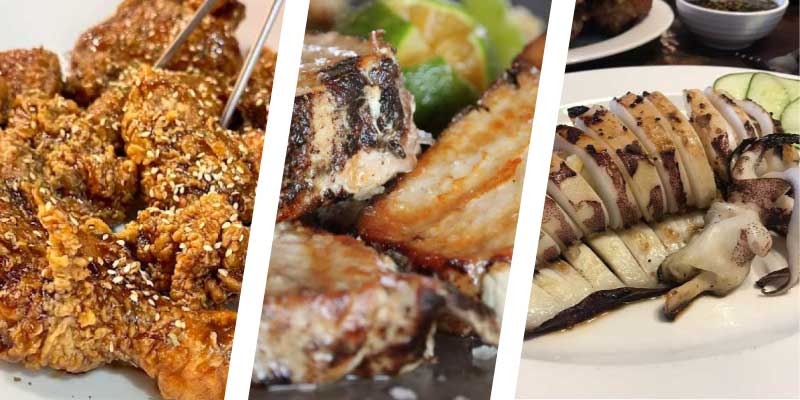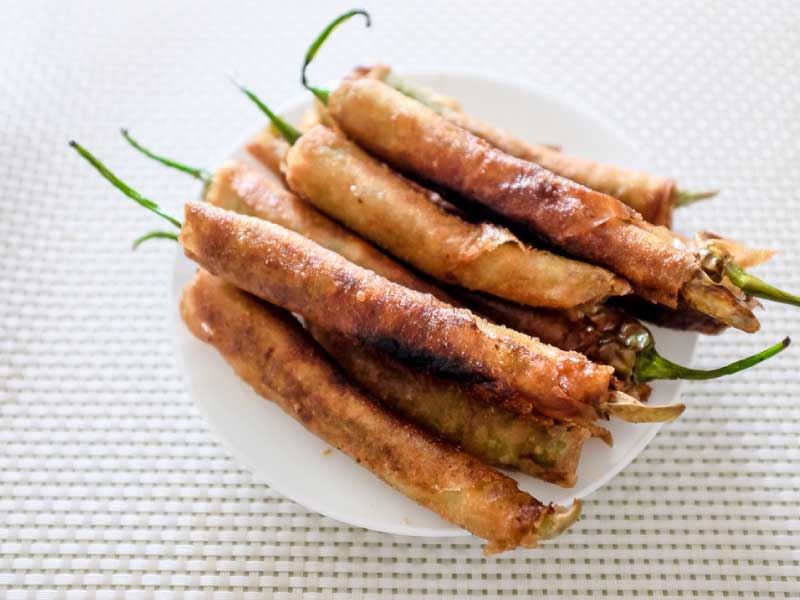Filipino Flavours!
Discover the rich and vibrant flavors of Filipino cuisine!

Bold Bites: The Fusion Power of Filipino Food
Filipino cuisine is a lively mix of indigenous, Spanish, Mexican, Malay, Chinese, and American influences, celebrated for its bold flavors and hearty dishes. Classics like adobo, sinigang, and lechon highlight the rich variety and depth of this unique culinary tradition.
Where are the roots?
Indigenous Austronesian traditions naturally include local tropical products like fruits, fish, and rice. During the Spanish colonial period, techniques such as marinating and roasting were adopted, along with ingredients like tomatoes and garlic, which became prominent in Filipino cuisine. Chinese influence is evident in dishes like noodles (locally known as pancit), lumpia (spring rolls), and soy sauce. American and Japanese touches can be seen in the variety of fried chicken and tempura-style seafood.
The key characteristics of Filipino cuisine are highlighted by the sour notes from tamarind, calamansi, and vinegar, which play a significant role. The salty flavors primarily come from fish and soy sauce, while sweetness is mainly reserved for desserts.

When visiting Japan, it’s almost a given that you’ll try sushi, just as you’d enjoy pizza in Italy or paella in Spain. Similarly, when you arrive in Coron, you should definitely sample some of the local specialties, which we’ll list for you here.
Lumpia: Lumpia is a popular Filipino snack, much like spring rolls, celebrated for its crispy wrapper and flavorful filling. It can be stuffed with a variety of ingredients, such as meat, seafood, or vegetables, making it a versatile treat that suits different preferences. The most popular lumpia wrappers are spring rolls and Dynamite. Spring rolls are typically filled with grilled vegetables, while Dynamite features a mid-sized green chili stuffed with cheese and ground pork or beef, then wrapped. Lumpia Dynamite is perfect as Pulutan, the food enjoyed while drinking. As the name suggests, this lumpia is meant to pack a spicy punch.
Sinigang: Sometimes referred to as sour broth, this Filipino soup or stew is known for its distinct sour and savory flavor. While tamarind is commonly used as the souring agent, other ingredients like unripe mangoes or rice vinegar can also provide the signature tangy taste.
Adobo: Philippine adobo is a well-loved Filipino dish and cooking method in Philippine cuisine. It typically involves browning meat, seafood, or vegetables in oil, then marinating and simmering them in vinegar, salt or soy sauce, and garlic. It’s widely regarded as the unofficial national dish of the Philippines.
Kare-Kare: Kare-Kare is a classic Filipino dish known for its rich and savory peanut sauce. It typically features stewed oxtail, beef tripe, pork hocks, pig’s feet, or other cuts of pork and beef, sometimes even offal. Vegetables like eggplant, Chinese cabbage, daikon, green beans, okra, and asparagus beans are commonly added to complete the dish.
Sisig: Sisig is a popular Filipino dish made with pork jowl, ears, belly, and chicken liver, seasoned with calamansi, onions, and chili peppers. It hails from Pampanga (Island of Luzon) and is a beloved staple of Kapampangan cuisine. It is usually served in a hot plate.
Arroz Caldo: Arroz caldo is a comforting Filipino dish of rice and chicken porridge, flavored with plenty of ginger and topped with toasted garlic, scallions, and black pepper. It’s typically enjoyed with calamansi or fish sauce on the side, along with a hard-boiled egg.
Crispy Pata: If you don’t have any cholesterol issues, this dish is a must-try! Crispy pata is a beloved Filipino delicacy made from a whole pork leg or shank. It’s boiled until tender, then deep-fried to perfection, resulting in an irresistibly crispy skin and juicy, flavorful meat. It’s usually served with a tangy and savory dipping sauce made of soy sauce, vinegar, and chili.

Halo-Halo: Halo-halo is a popular Filipino dessert of mixed (halu-halo) ingredients served with shaved ice and milk. It is a layered concoction of sweet beans, fruits like jackfruit and banana, ube (purple yam), jellies, and other sweet treats such as leche flan, often topped with ice cream or condensed milk.
The list could be much longer, especially when considering locally developed recipes that aren’t widely available. The dishes mentioned above are typically found all over the country, including, of course, Coron.If you’re craving a change from Filipino cuisine, check out our Best Restaurants in Coron page, featuring top-notch Filipino and international dining options in Coron.
Are the restaurants in Coron expensive?
There are more than 130 restaurants in Coron that will match all the likes and budgets.
Is the service water provided in restaurants safe to drink?
The restaurants must serve by law purified water. This is not bottled water but is water that has gone through a purificatopn process making it safe to drink
What are effective strategies to prevent stomach-related infections?
Maintaining the highest standards of hygiene is essential. According to numerous studies, up to 90% of food poisoning cases can be prevented simply by washing hands before eating. In the Philippines, there may be bacteria, viruses, parasites, toxins, or chemicals that may not be commonly found in the environments where you typically dine. While the risk of contracting food poisoning exists, it is generally low when proper food safety practices are followed.
Wash your hands frequently, especially after activities such as riding a motorbike, swimming in the sea, or touching handrails and other surfaces exposed to dirt. Most restaurants that meet basic standards of hygiene and comfort should provide a washbasin and hand soap for their customers.
If you’re concerned about stomach aches, we recommend dining only at restaurants that are properly registered and have up-to-date Sanitary Permits, along with accreditations from the DENR (Department of Environment and Natural Resources) and PCSD (Palawan Council for Sustainable Development), ensuring the facilities follow correct procedures and maintain proper conditions.
Is it safe the street food in Coron?
Street food in the calenderias of Coron is generally safe to eat; just make sure to follow basic hygiene practices before enjoying it.
- Hot and freshly cooked items are usually safer than those that were cooked few hours ago and still sitting there.
- Choose a stall where the vendor maintains a clean working area and uses gloves rather than handling food directly with bare hands.
- Whenever possible, choose food stalls that display a valid business permit and sanitary certification.
I'm experiencing stomach discomfort, what should I do?
If you’re feeling unwell with symptoms like nausea, bloating, or diarrhea, it’s best to rest and monitor your condition. Avoid heavy meals and consider fasting for up to 24 hours if symptoms are severe. Stay hydrated by sipping clean water or oral rehydration solutions. If symptoms persist or worsen, seek medical attention.
What means the +, and the ++?
Some restaurants and accommodations include additional charges to the listed prices. A “+” typically refers to a service charge, usually between 7% and 10%. Meanwhile, “++” generally covers both the service charge and taxes, which amount to around 12%. So, if you see something priced at 1000₱++, it might actually cost about 1220₱ after adding the charges and taxes.
Why the restaurants don't include the service charge and taxes on the listed price?
A lower listed price can serve as a hook to attract more customers. Once you’re seated at the table, it’s highly unlikely you’ll leave the restaurant, even with additional charges that make you reach for a calculator to figure out the total cost of your meal.
Do all the restaurants of Coron apply these extra charges?
Only about 30% of restaurants in Coron Town include the final price on their menu. We make sure to highlight those that list their prices clearly, without any surprises.
The service hasn't been that good, should I still pay the service charge?
Well, if the service hasn’t met the minimum standards, you can complain, and it might be deducted from the bill. However, since it’s written in the menu, you are expected to pay it.
Is it possible to pay with card?
Card payments are accepted in only a few restaurants. Banks provide card payment devices only to companies fully registered with the BIR. Businesses that are not registered or are still in the process cannot accept card payments.
Is there a fee for paying by using debit or credit card?
It is illegal to impose surcharges or extra fees for payments made with debit or credit cards in the Philippines. The Department of Trade and Industry regularly reminds establishments to avoid taking advantage of cardholders by enforcing these unlawful charges.
Is there a fee for paying by using debit or credit card?
It is illegal to impose surcharges or extra fees for payments made with debit or credit cards in the Philippines. The Department of Trade and Industry regularly reminds establishments to avoid taking advantage of cardholders by enforcing these unlawful charges.
Is it mandatory to tip when settling the bill?
It is not mandatory neither necesary but tipping is highly appreciated in the Philippines. The amount doesn’t matter, any tip will be greatly appreciated. In restaurants where a service charge is added in the bill, tipping is generally not expected.